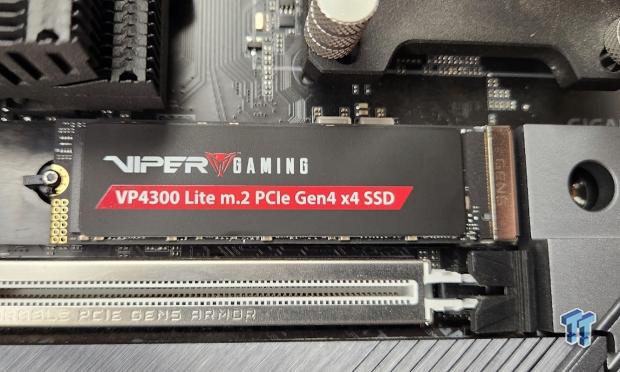
The Bottom Line
Pros
- + Gaming
- + Sequential throughput
- + Pricing
Cons
- - None
Should you buy it?
AvoidConsiderShortlistBuyIntroduction & Drive Details
Last month, we had the pleasure of testing Patriot's 2TB VP4300 Lite and found it to be the best bang for the buck we've ever come across. Patriot's Viper VP4300 Lite 2TB, not to be confused with its predecessor, the Viper VP4300 gave us more of everything we've come to love about this 100% Chinese-made hardware configuration.
This particular hardware configuration, being a Maxio Tech MAP1602-C 4-channel DRAMless controller in front of a YMTC 2,400 MT, 232-Layer TLC flash array, has forged ahead into territory where no flash-based DRAMless SSD has gone before. It is the first and still only retail 4-channel DRAMless hardware configuration capable of fully saturating the PCIe Gen4 x4 interface, delivering up to 7,400 MB/s throughput. Additionally, it is the very first, and still only, DRAMless hardware configuration capable of delivering sufficient throughput to qualify for legit usage as PlayStation 5 M.2 storage expansion.
Simply stated, Patriot's VP4300 Lite, and those of its kind, have become, overall, our favorite go-to SSD for the following reasons. Cost. This hardware configuration can be had for less than 5 cents per gigabyte, and this is for some of the fastest, most enduring TLC flash on the planet. TLC for the price of QLC? Gotta love that.
Heat. Being that this is a 4-channel controlled DRAMless SSD, it sips just a fraction of the power of traditional enthusiast-grade SSDs. This thing just doesn't get hot. It is single-sided, making it ideal for laptops and easier to cool. Performance. This hardware configuration delivers more real-world performance, with half the channels than the vast majority of contemporary 8-channel SSDs with onboard DRAM.
Cheaper, faster, cooler, it doesn't get much better than that, or does it? Well, turns out that it does because now we can get more of it, and with improved real-world performance to boot. Amazing. Patriot's VP4300 Lite now comes in a 4TB capacity option. It is again a single-sided SSD, which is quite the accomplishment, being it is the first single-sided 4TB SSD of its kind. Do you want the perfect high-capacity laptop storage upgrade? Here you go.
Okay, now let's get into the review so we can demonstrate to you exactly why the 4TB Viper VP4300 Lite is our new favorite SSD.
Drive Details
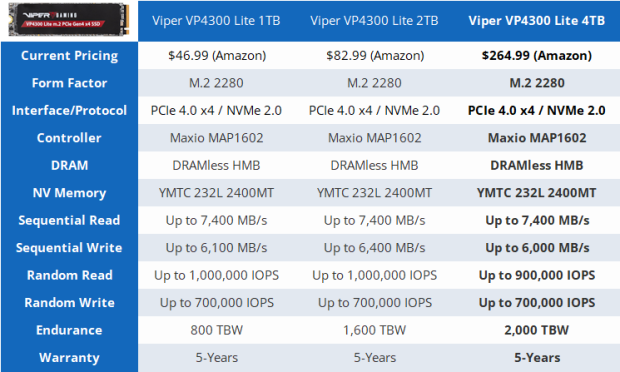
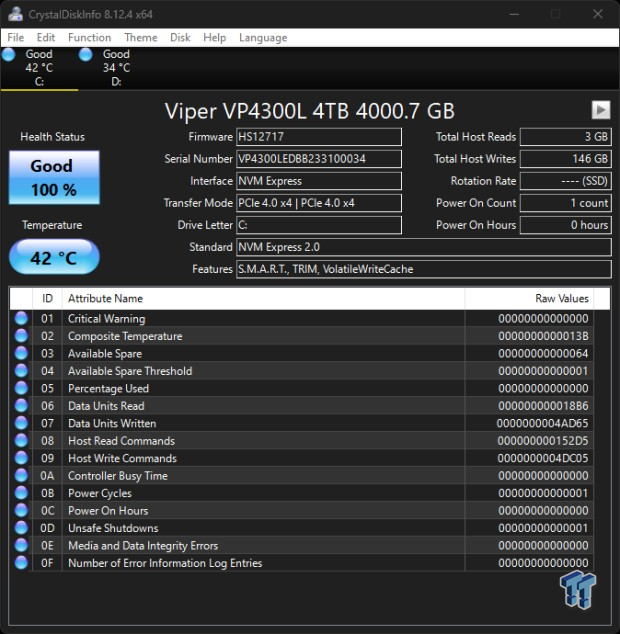
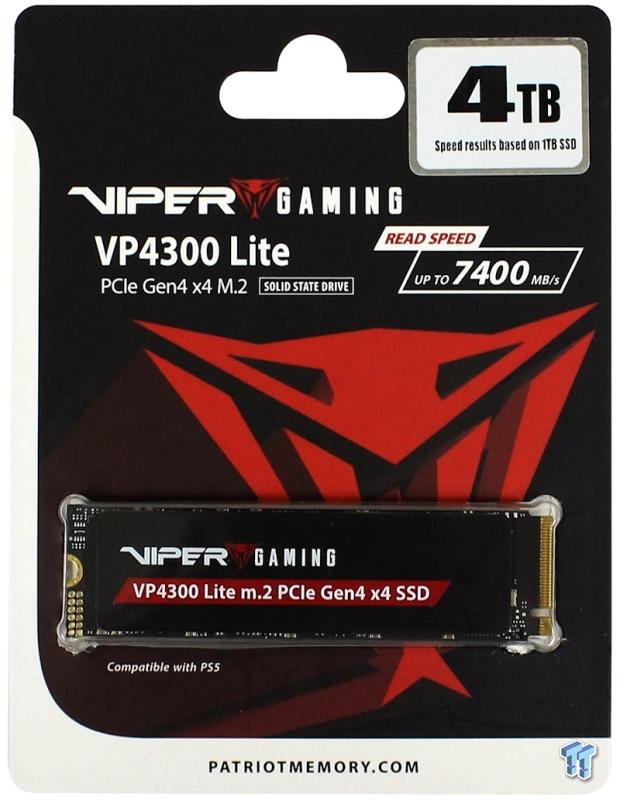
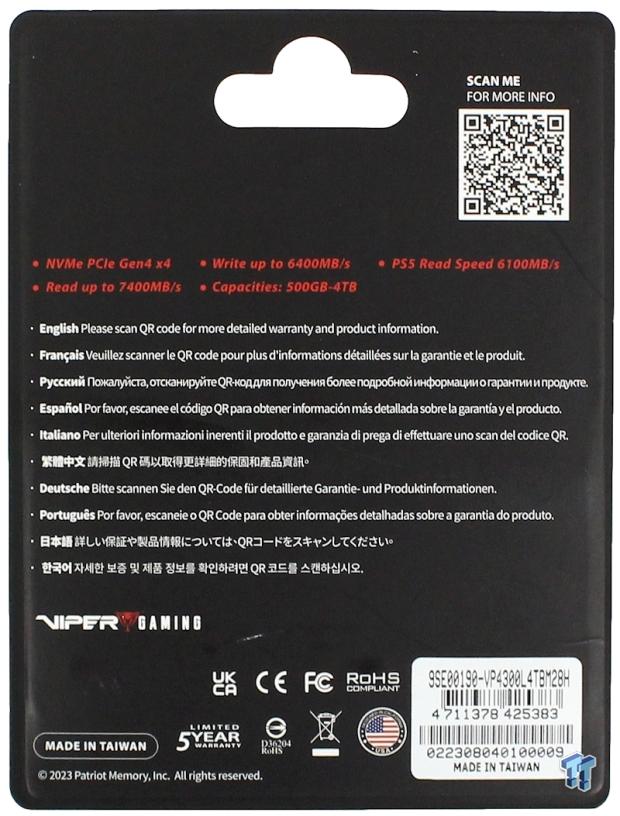


As mentioned, the drive is a preferred single-sided design, the first of its kind for a 4TB offering. We love that. We will also point out that the controller side label is not your ordinary label, but rather, it is a special edition ultra-thin cooling graphene-coated metallic heat spreader.
Jon's Test System Specifications
Intel Test System
- Motherboard: GIGABYTE Z790 AORUS Tachyon
- CPU: Intel Core i9-13900KS - Buy from Amazon
- Cooler: Alphacool Eissturm Hurricane Copper 45 - Buy from Amazon
- RAM: Sabrent Rocket DDR5 32GB - Buy from Amazon
- Graphics Card: MSI SUPRIM X RTX 3080 12GB - Buy from Amazon
- Case: PrimoChill's Praxis Wetbench - Buy from Amazon
- Power Supply: be quiet! Dark Power Pro 12 1200W - Buy from Amazon
- OS: Microsoft Windows 11 Pro 64-bit - Buy from Amazon
AMD Test System
- Motherboard: GIGABYTE X670E AORUS Master
- CPU: AMD Ryzen 9 7950X - Buy from Amazon
- Cooler: Alphacool Eissturm Hurricane Copper 45 - Buy from Amazon
- RAM: Sabrent Rocket DDR5 32GB - Buy from Amazon
- Graphics Card: MSI SUPRIM X RTX 3080 12GB - Buy from Amazon
- Case: PrimoChill's Praxis Wetbench - Buy from Amazon
- Power Supply: be quiet! Dark Power Pro 12 1200W - Buy from Amazon
- OS: Microsoft Windows 11 Pro 64-bit - Buy from Amazon
Because we at TweakTown like to be first at everything whenever we can, we will present our storage performance results for the test subject on both 13th Gen Intel and 7000 Series AMD platforms going forward for the foreseeable future. Because Intel still delivers the best real-world storage performance, (Look Here), our running chart will continue to be Intel-based until AMD can deliver better real-world storage performance than its rival.

Sony PlayStation 5 - M.2 Storage Expansion
PS5 Read Performance
With Sony's wildly popular PlayStation 5 console now enabled for M.2 NVMe SSDs to be used as fast storage expansion, we include results for PS5 compatible SSDs we test as a part of our reviews going forward.
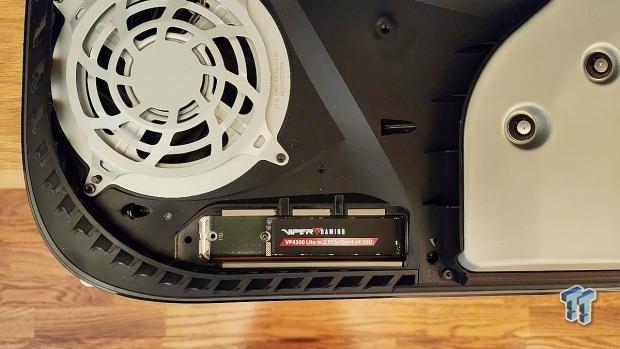
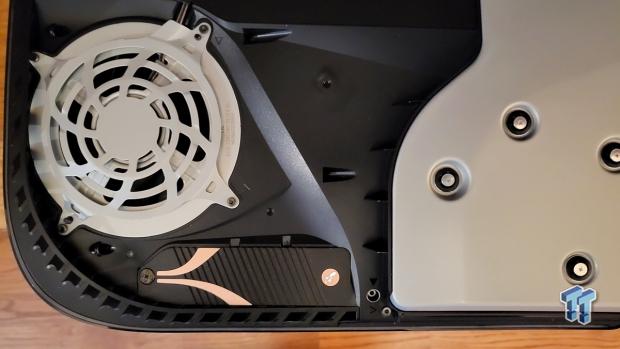
For 5,500 MB/s plus capable SSDs that don't have an adequately sized PS5 compatible heatsink or other SSDs where the heatsink provided doesn't fit right and can be removed, we both use and recommend Sabrent's unparalleled PS5 heatsink available HERE. We are of the opinion that this SSD's hardware configuration runs so cool that a heatsink is not a requirement for use as PS5 storage expansion. The first time we've been of that opinion.
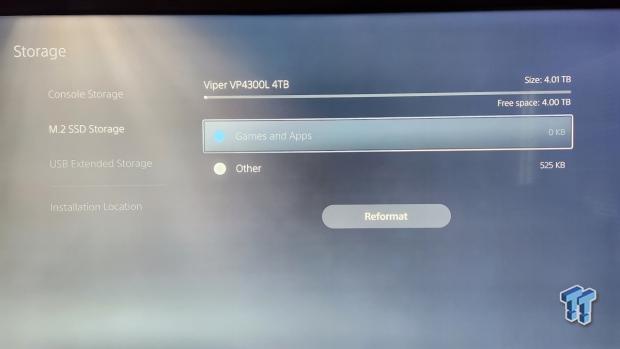
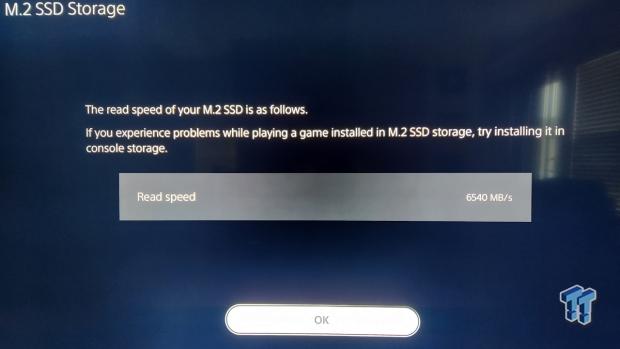
We only chart SSDs that can deliver a minimum of 5,500 MB/s read, which is Sony's original recommendation.
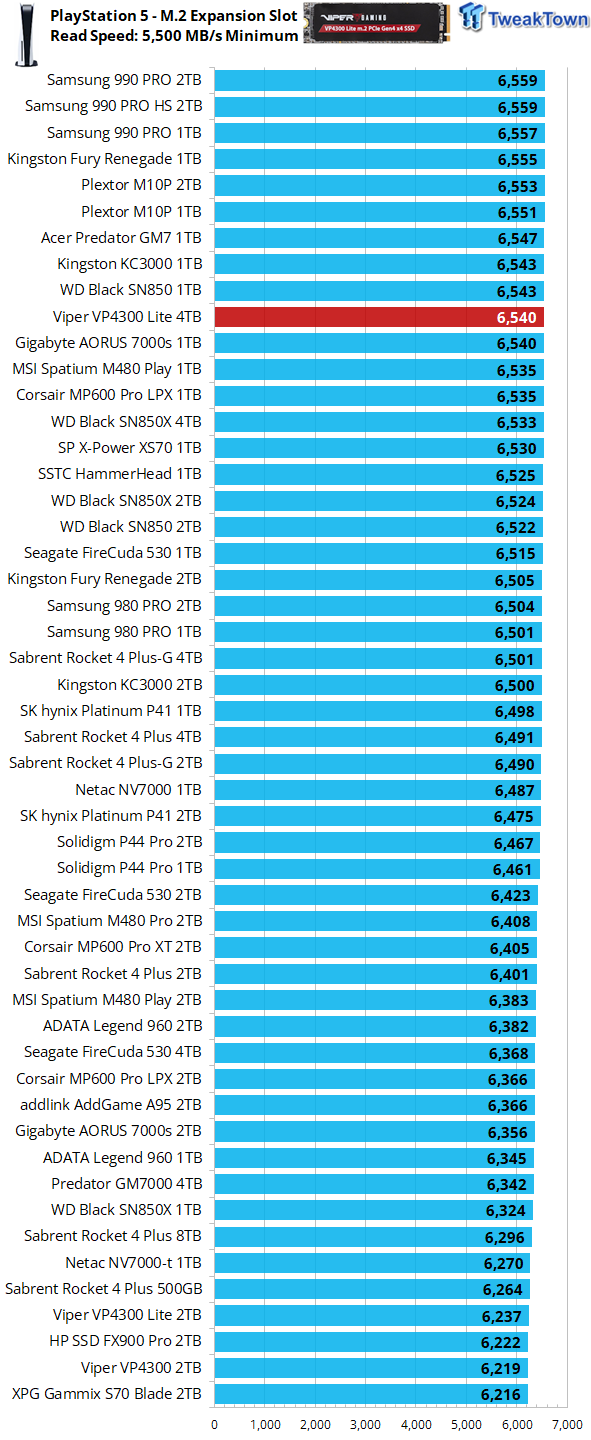
At over 6,500 MB/s, the VP4300 Lite 4TB delivers more here than any 4TB SSD we've ever tested. Additionally, it is giving us our first glimpse that it can deliver even more real-world performance than the 2TB model that we love so much. Impressive.
Synthetic Benchmarks: CDM, Anvil, ATTO
CrystalDiskMark
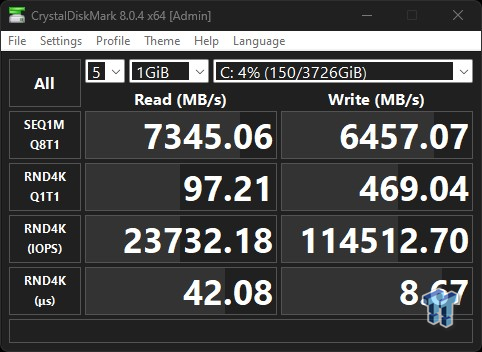
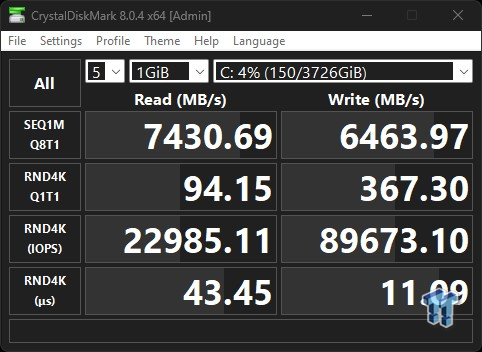
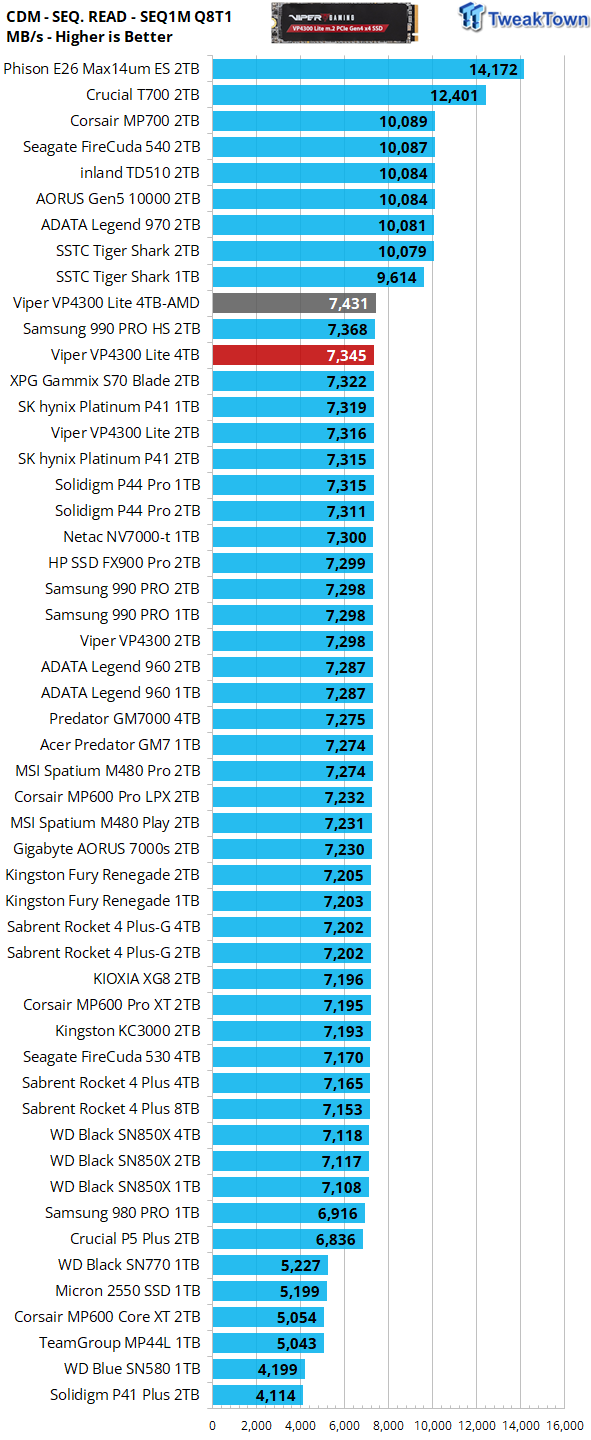
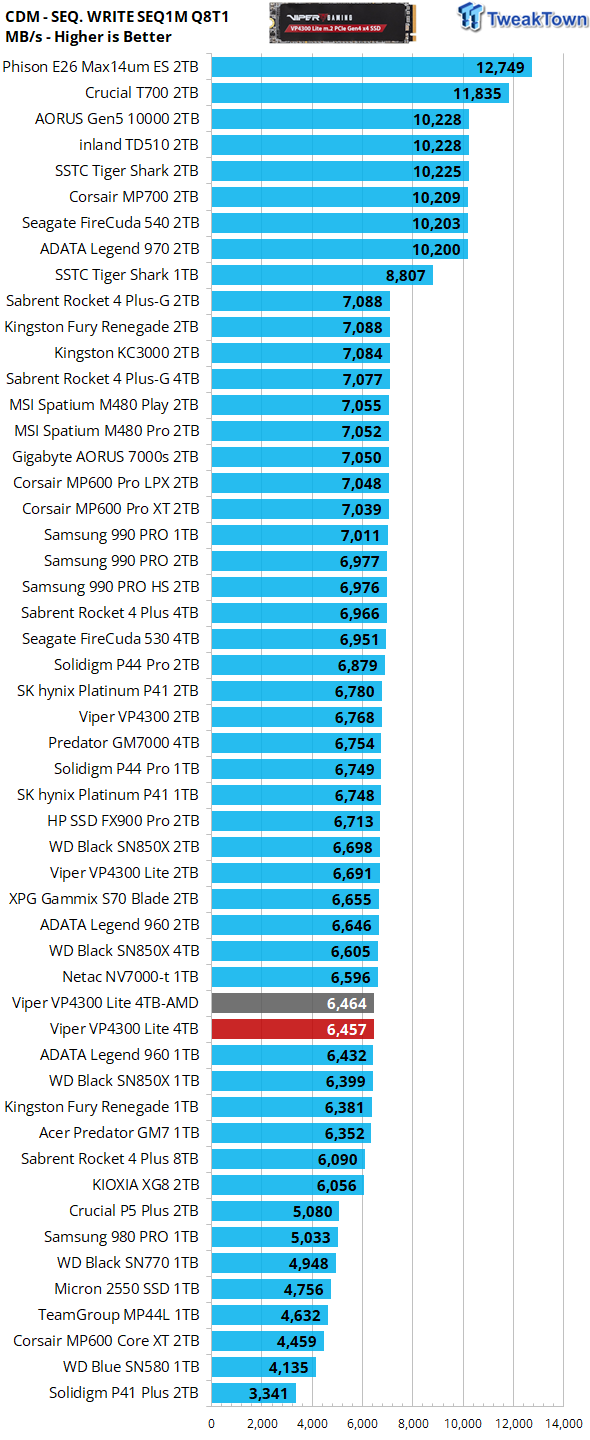
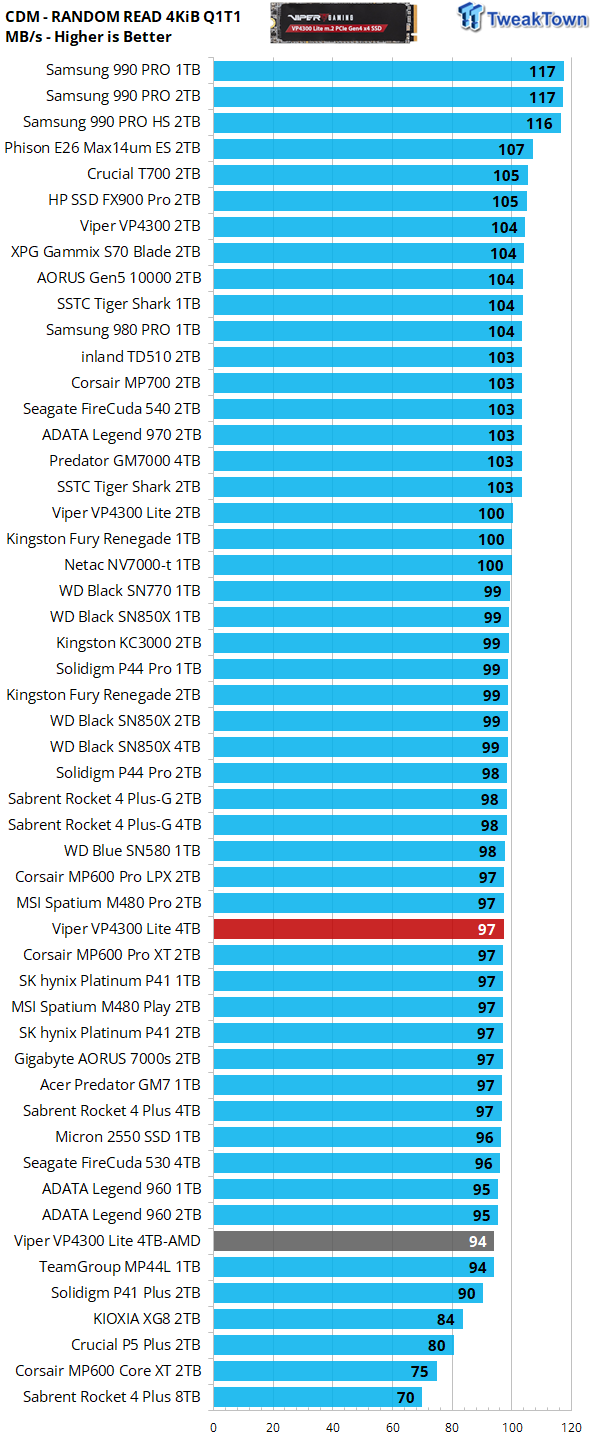
We employ CDM as our standard measurement for both sequential throughput and Q1T1 random read. In terms of sequential throughput, we find our test subject fully capable of meeting and exceeding quoted up to specifications (which are given for AMD). Looking at 4K QD1 random read, our test subject is cranking out a respectable 97 MB/s. However, that is 3% lower than the 2TB model, verifying that the 4TB model is arrayed with higher capacity die, which typically signals lower real-world performance. But this is not your typical SSD, as we will see when we get into performance that matters.
Anvil's Storage Utilities
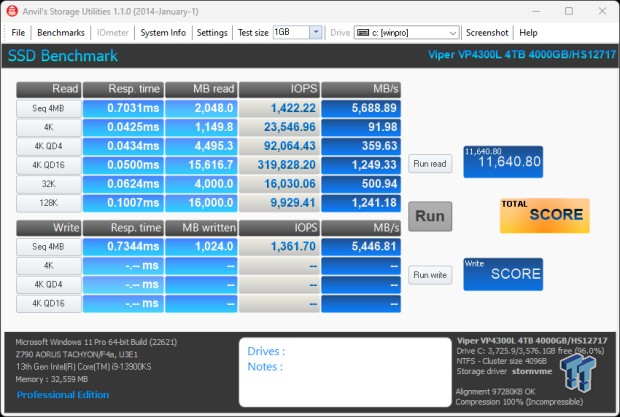
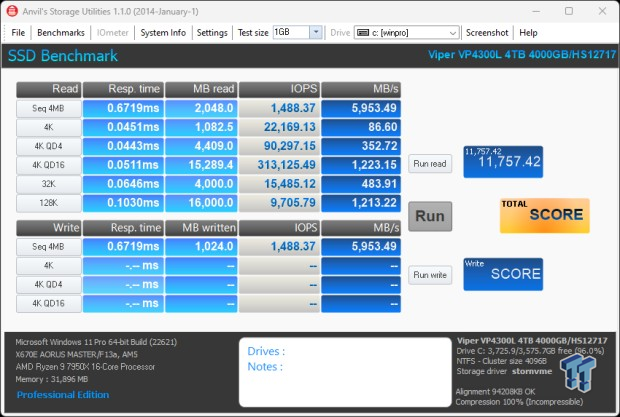
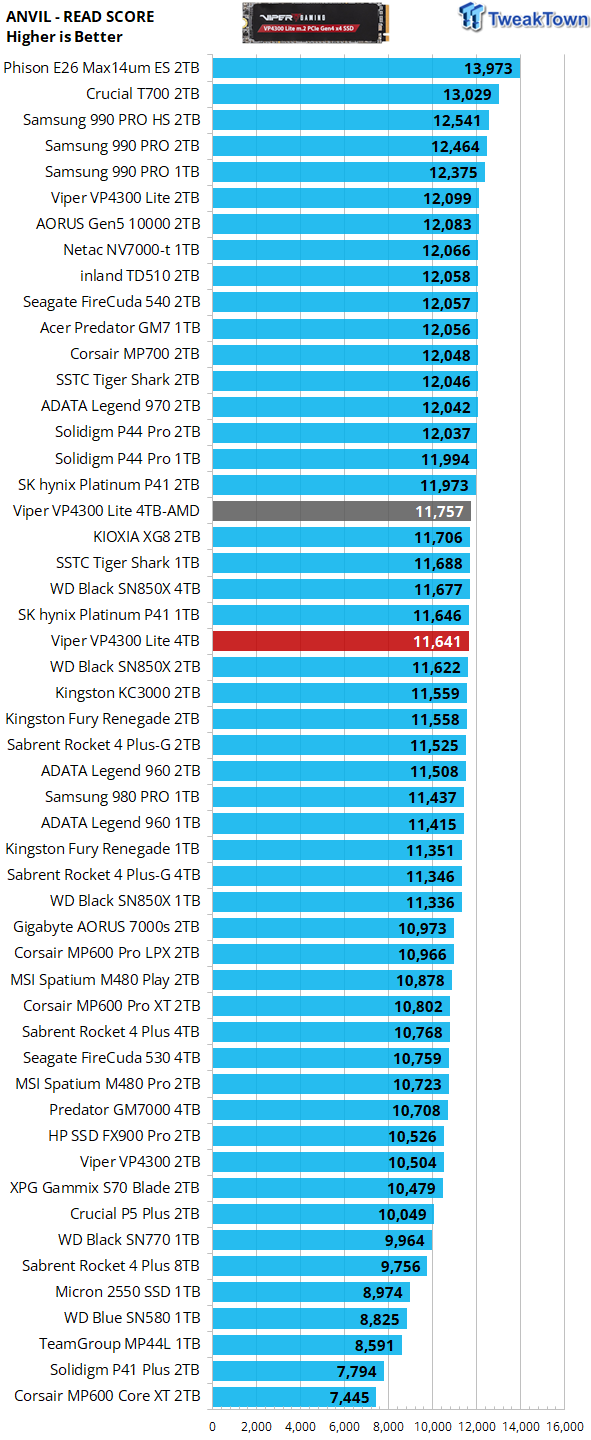
Again, and for the same reason, the 2TB VP4300 Lite delivers higher synthetic performance than our 4TB test subject. Even so, it delivers better than most 8-channel PCIe Gen4 SSDs that populate our chart.
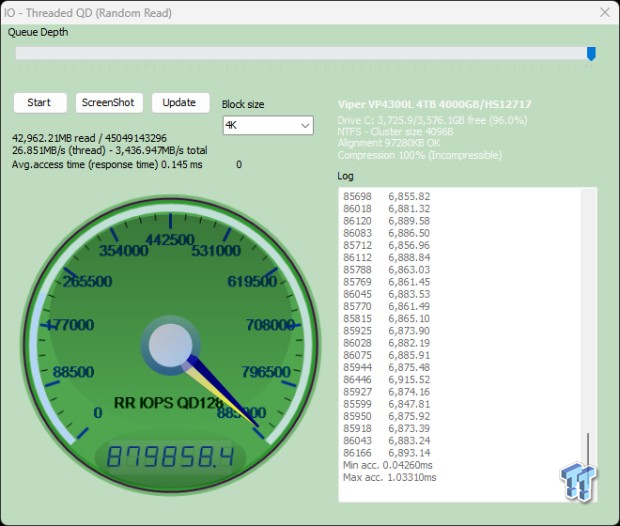
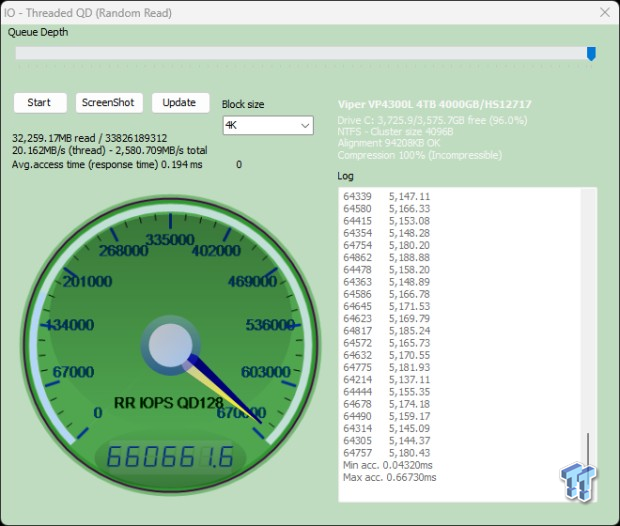
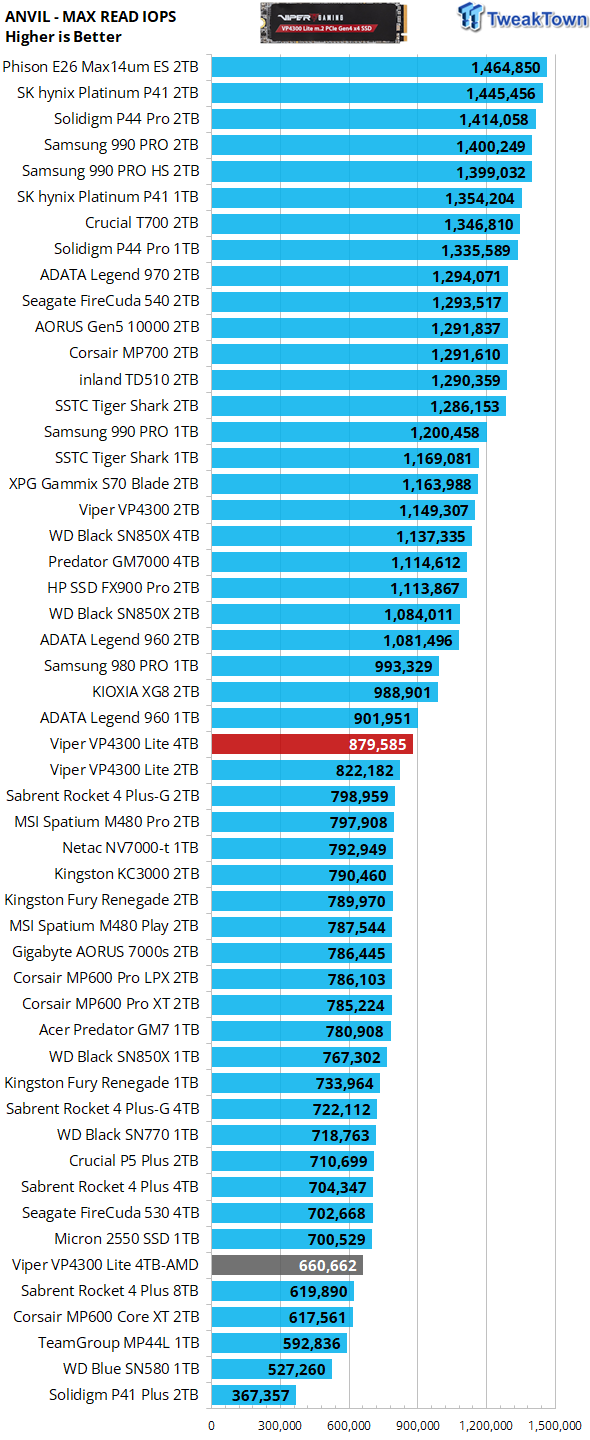
We employ Anvil's random read test as our standard for measuring max random read IOPS. This test is very accurate as at its core is Iometer skinned over. We test at QD128. Our DRAMless contender cranks out an impressive 879K random read IOPS on our Intel system, this time getting the better of the 2TB model.
ATTO
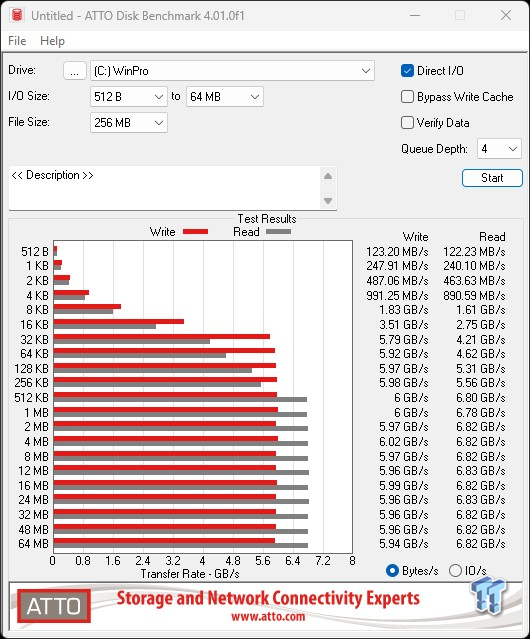
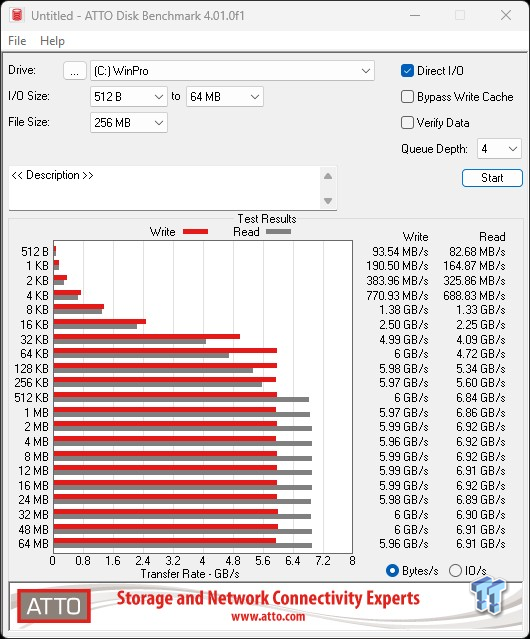
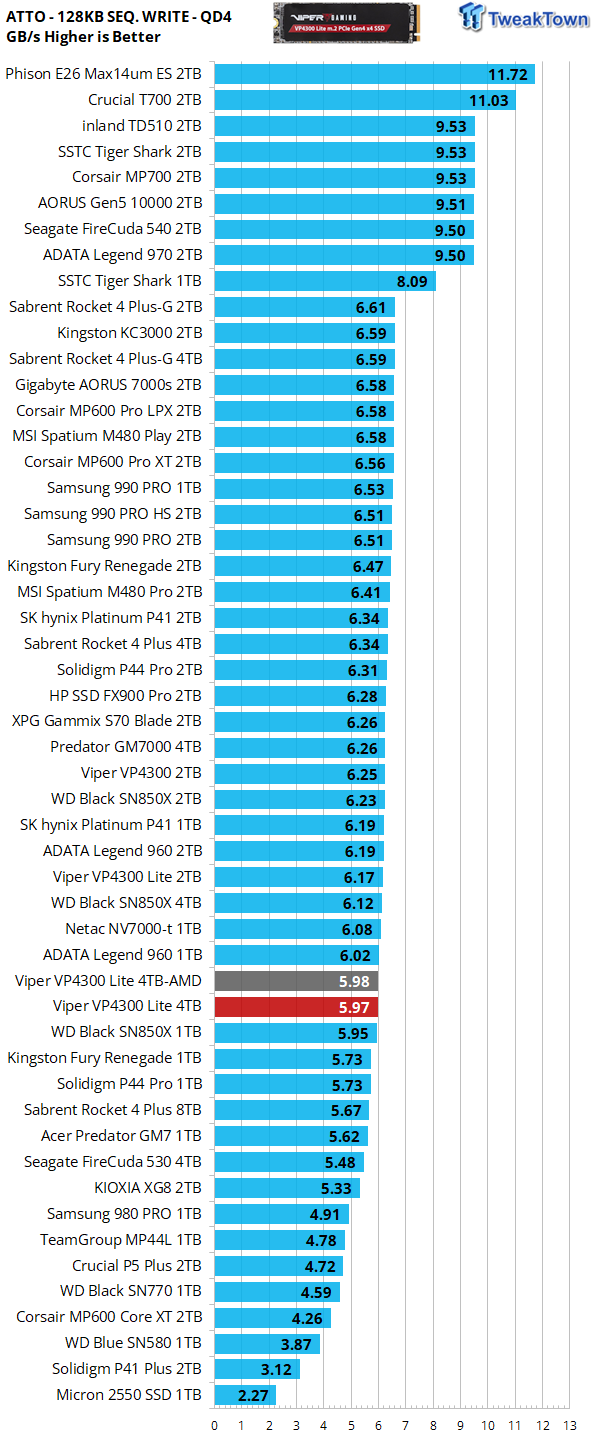
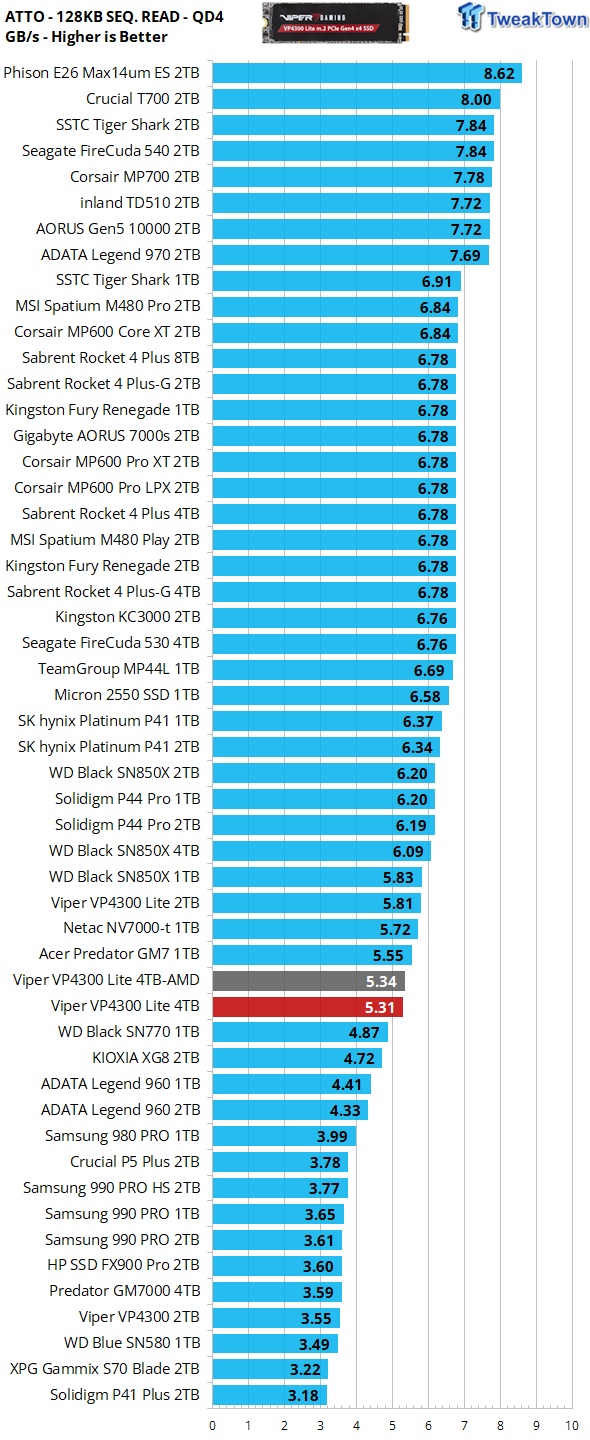
ATTO gives us a clear picture of what transfer sizes a particular SSD favors in terms of sequential throughput. We chart 128K transfers. As expected, our test subject favors sequential transfers of 512K or larger when serving data to the host (reading) and 64K or larger when programming (writing) data.
Real-World Testing: Transfers, 3DMark SSD Gaming Test, PCM10 Storage
Transfer Rates
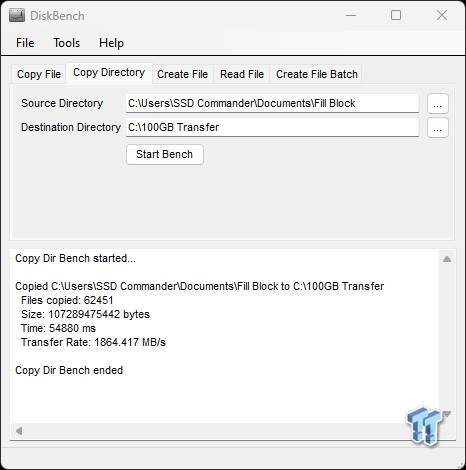
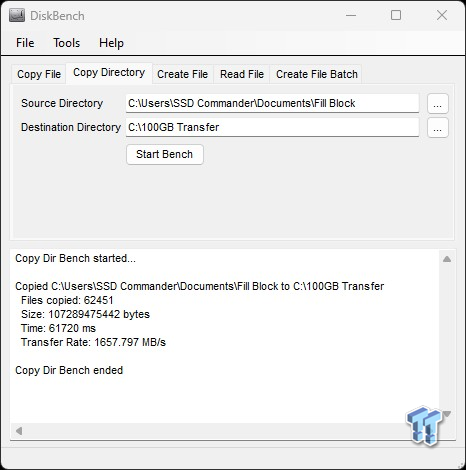
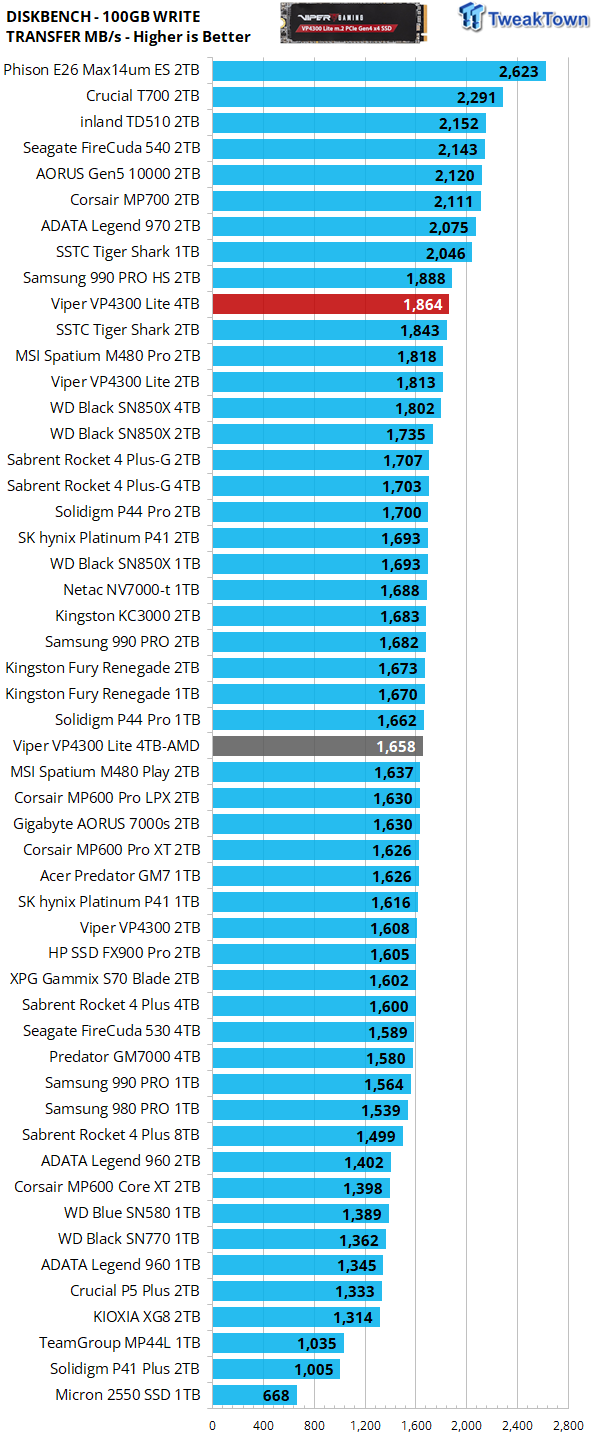
Our 100GB data transfer test is not your ordinary 100GB of data. Ours is a crushing mix composed of more than 62K files. Write performance, random or sequential, is an infrequent operation, and as such, we do not consider it an important performance metric in the consumer space. An example is how often a game is installed vs. how often it's played.
Although it's not an important metric in the real world, we are nonetheless impressed with this new lab record for a 4TB flash-based SSD. It's beating the 2TB model and more impressively, delivering the second-best ever for any PCIe Gen4 M.2 SSD we've ever tested. Outstanding.
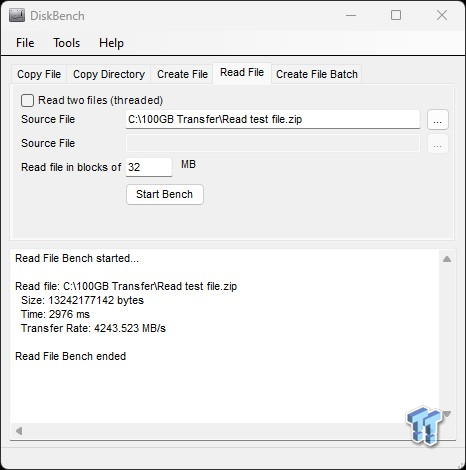
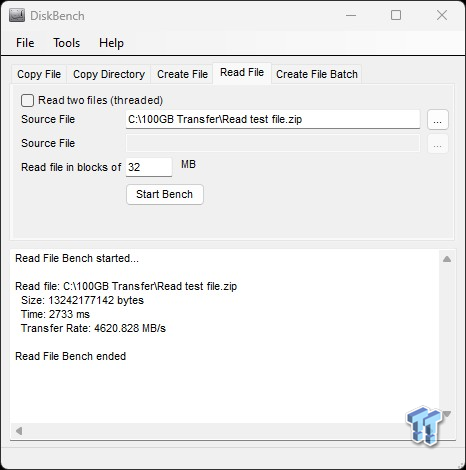
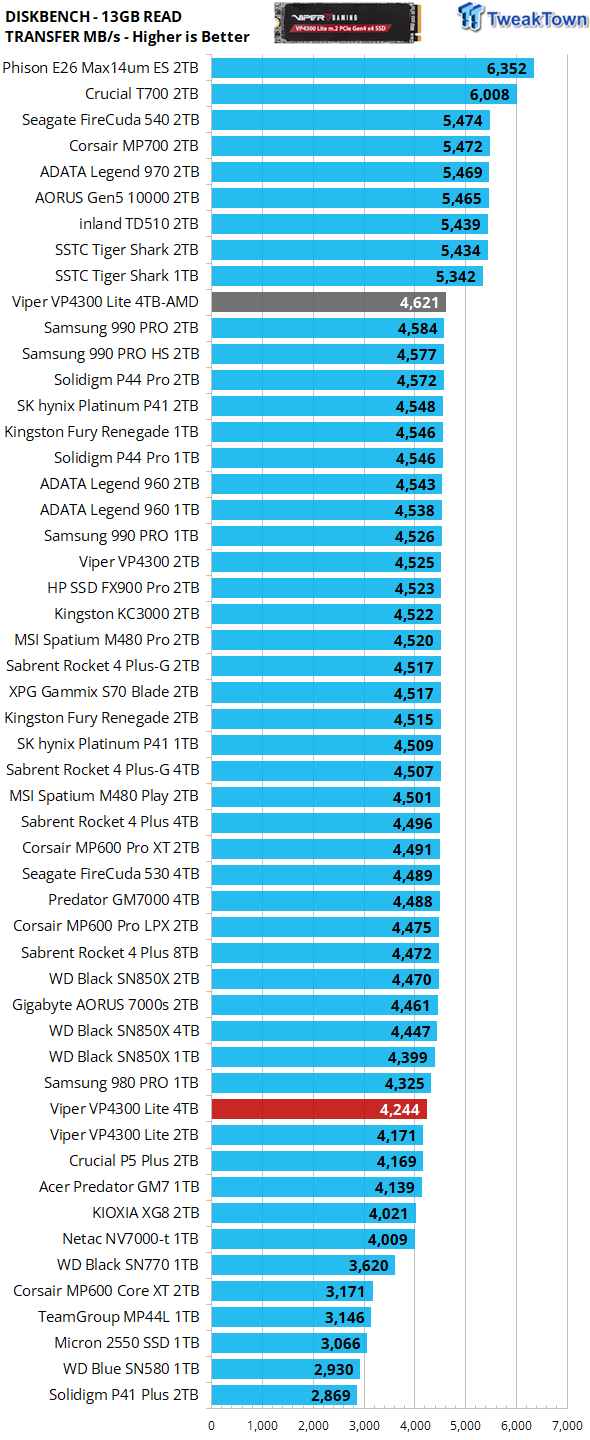
Unlike programming (writing) data, serving data to the host (reading) data is always an important performance metric as it relates to the consumer space. 4,244 MB/s for a DRAMless SSD running on our Intel system is yet again another lab record for a flash-based DRAMless SSD. Impressive.
3DMark SSD Gaming Test
UL's newest 3DMark SSD Gaming Test is the most comprehensive SSD gaming test ever devised. We consider it superior to testing against games themselves because, as a trace, it is much more consistent than variations that will occur between runs on the actual game itself. This test is the same as running the actual game, just without the inconsistencies inherent to application testing. In short, we believe that this is the world's best way to test an SSD's gaming prowess and accurately compare it against competing SSDs. The 3DMark SSD Gaming Test measures and scores the following:
- Loading Battlefield V from launch to the main menu.
- Loading Call of Duty Black Ops 4 from launch to the main menu.
- Loading Overwatch from launch to the main menu.
- Recording a 1080p gameplay video at 60 FPS with OBS (Open Broadcaster Software) while playing Overwatch.
- Installing The Outer Worlds from the Epic Games Launcher.
- Saving game progress in The Outer Worlds.
- Copying the Steam folder for Counter-Strike Global Offensive from an external SSD to the system drive.
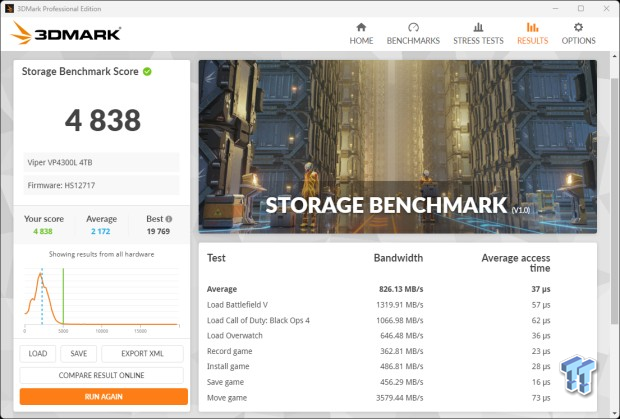
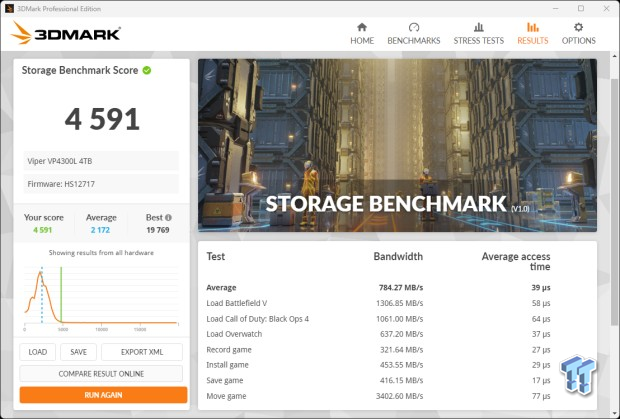
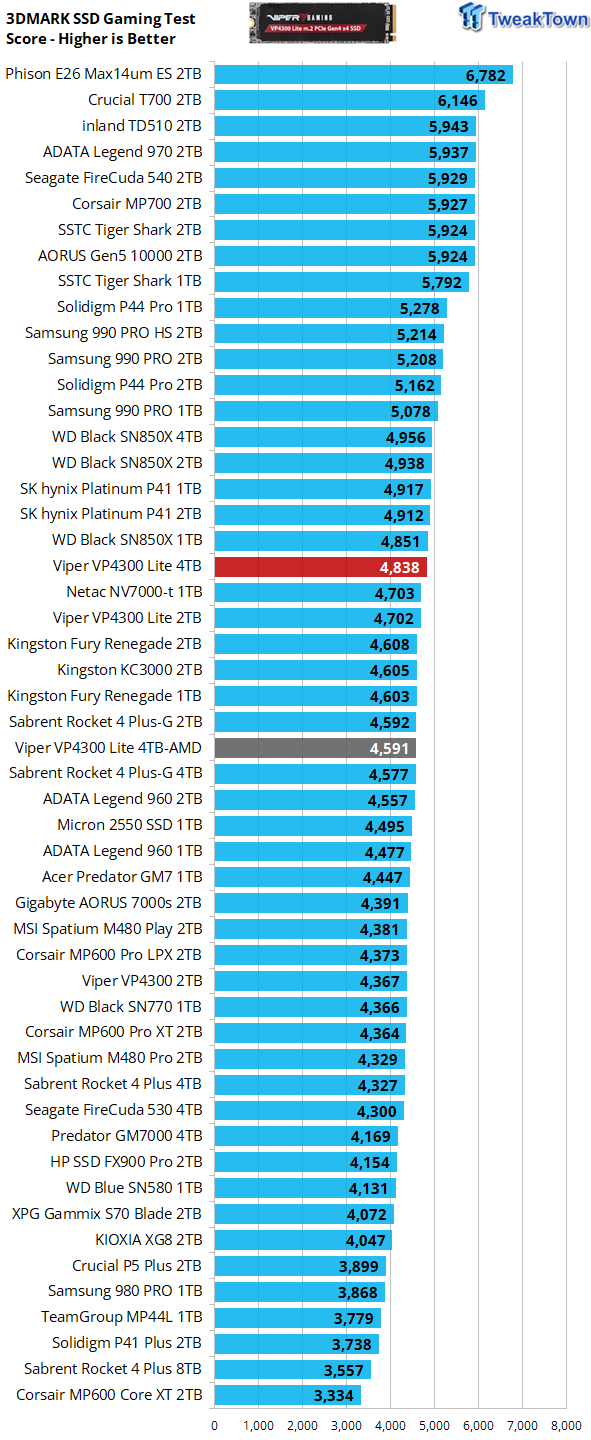
Gaming is a performance metric that matters to the majority of DIY consumers, especially to the enthusiast crowd that TweakTown caters to. Now we've reached the point where results start to matter as they are a direct reflection on user experience. Absolutely stunning performance here. It is the fifth best for any PCIe Gen4 SSD series. This drive makes for a better gaming SSD than most fire-breathing 8-channel SSDs with onboard DRAM and does so with half the channels, half the power draw, half the heat, and double the capacity. It's easy to see why this is our new favorite SSD.
PCM10 Storage Tests
PCMark 10 Storage Test is the most advanced and most accurate real-world consumer storage test ever made. There are four different tests you can choose from; we run two of them. The Full System Drive Benchmark and the Quick System Drive Benchmark. The Full System Drive Benchmark writes 204 GB of data over the duration of the test. These tests directly correlate with mainstream user experience.
PCMark 10 Full System Drive Benchmark
This particular test writes 204GB data and covers a broad range of common consumer tasks, including booting Windows 10, file transfers, Adobe and Office applications, and startup times for games, including Battlefield V, COD Black Ops 4, and Overwatch. Unlike synthetic numbers, this is comprehensive real-world data, which is why we use it to rank SSDs in terms of user experience.
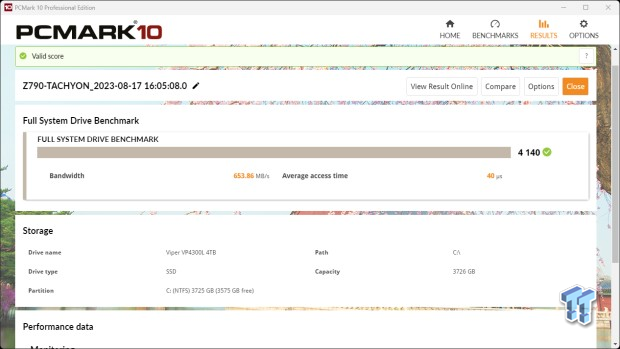
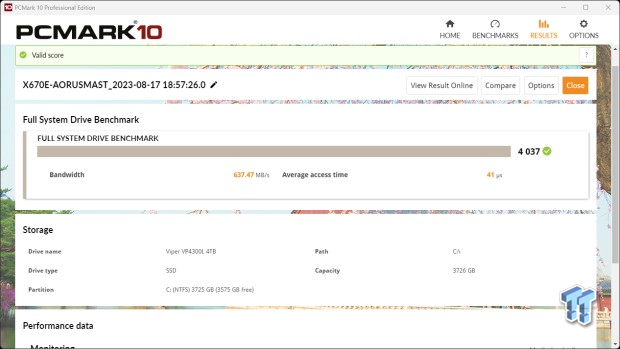
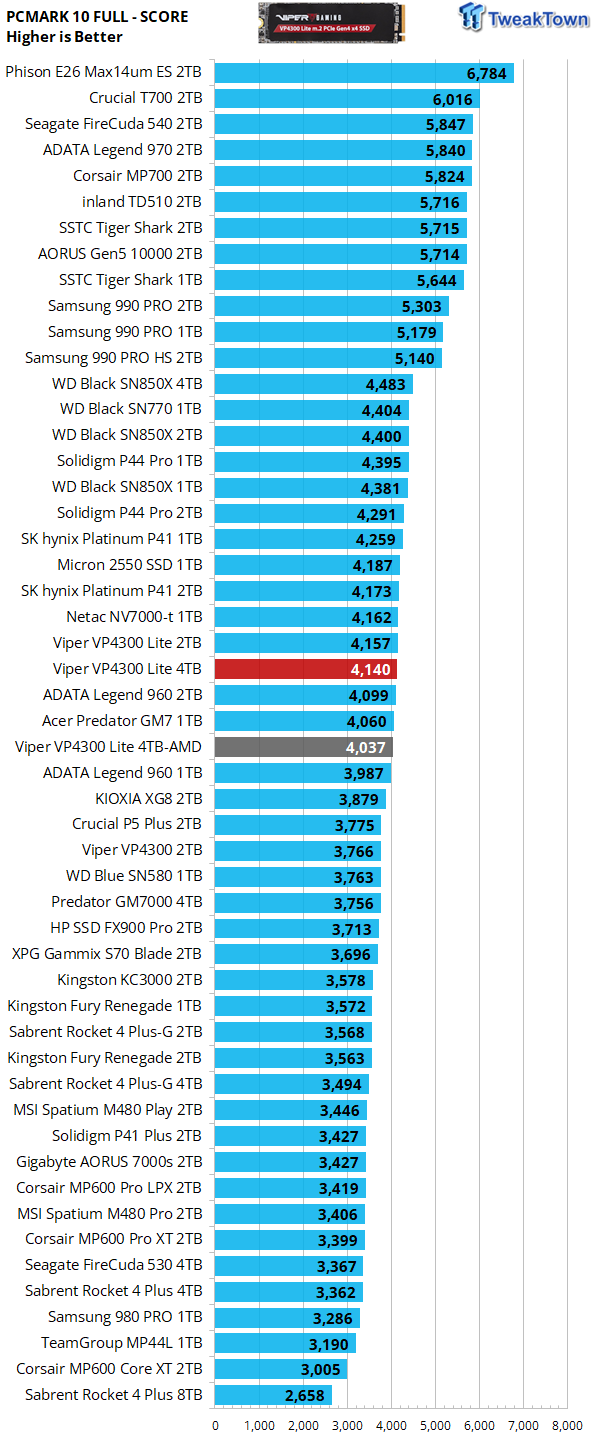
As expected, based on previous experience, our test subject handles heavy consumer workloads exceptionally well. For a bit of perspective, there is no B47R arrayed SSD ever made that can run with our capacious DRAMless contender.
PCMark 10 Quick System Drive Benchmark
The Quick System Drive Benchmark writes 23 GB of data over the duration of the test.
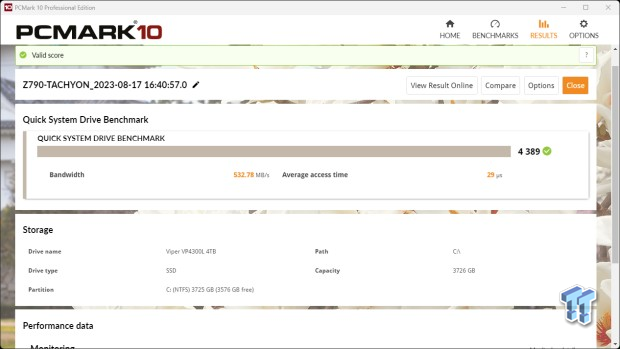
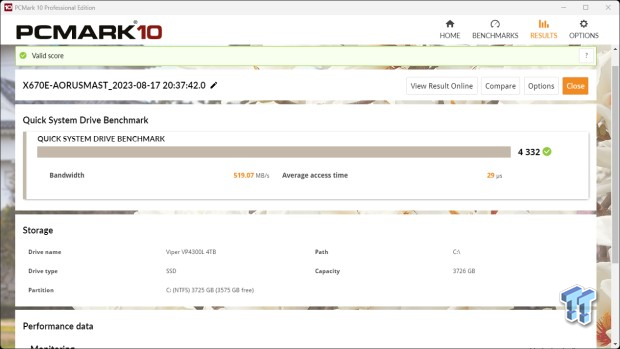
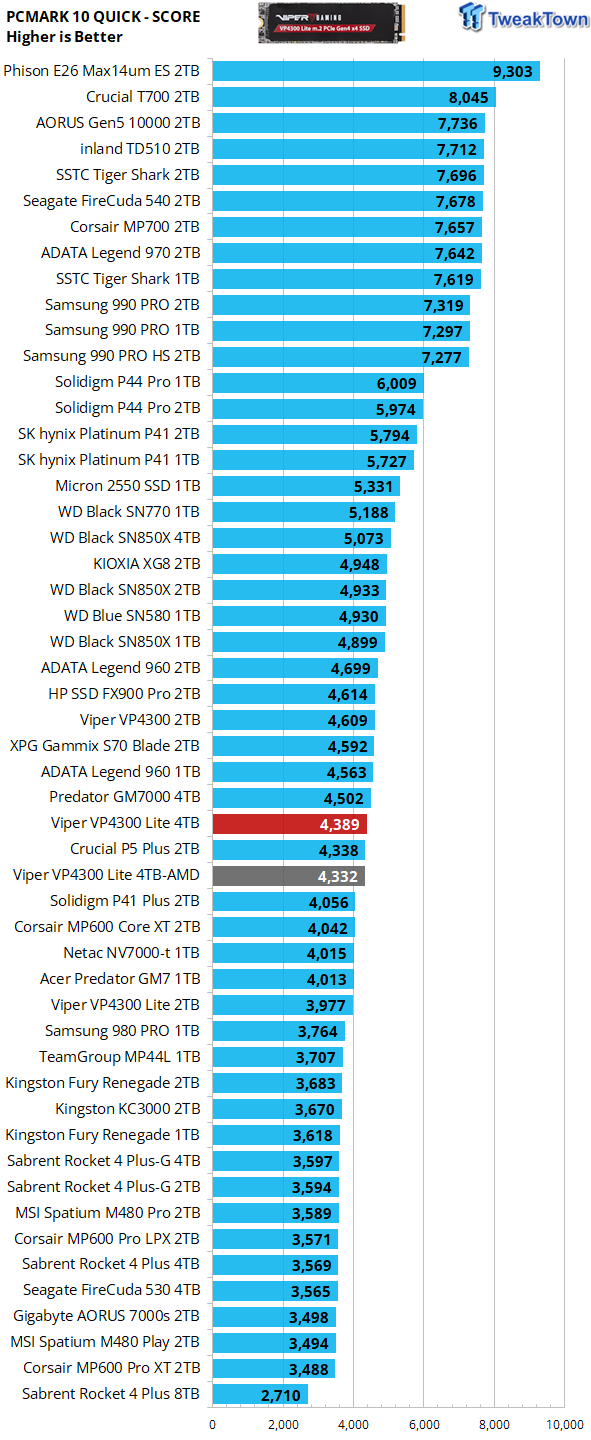
It's not nearly as dominating here, but it's still significantly better than any E18-controlled SSD can deliver and doing so with half the channels at its disposal. Additionally, it's by far the best showing for any capacity point sporting this hardware configuration.
Final Thoughts
It turns out that 4TB of the coolest running, single-sided, lowest cost, PS5 compatible storage on the planet is also one of the best PC gaming SSDs ever made. With this drive, 4TB is the new 2TB. 4TB for the masses, gotta love that.
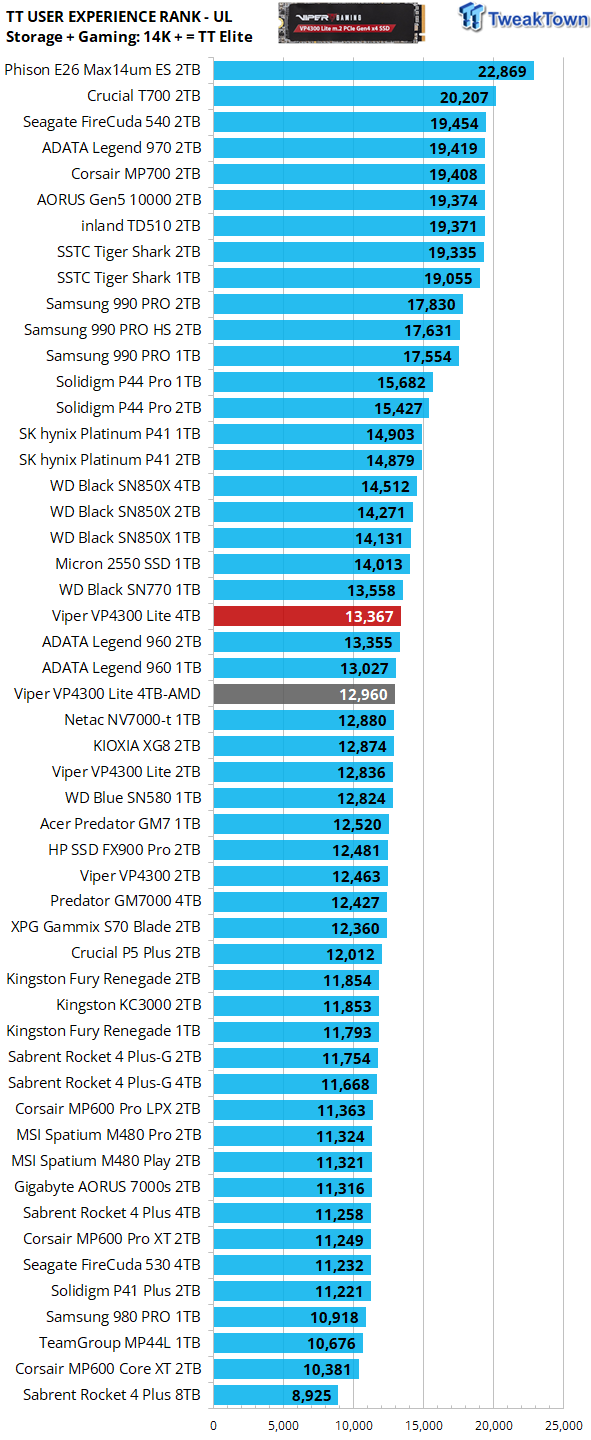
We rank SSDs in terms of overall user experience (performance where it matters most) as expressed by PCMark 10 storage and 3DMark gaming storage tests. We consider a user experience score of 14K or more to verify an SSD as a TweakTown Elite performer. Overall, this is the third-highest user experience score ever for a flash-based DRAMless SSD. Our test subject is essentially tied with the 1TB WD Black SN770 and roughly 600 points behind Micron's 2550. However, we will take the VP4300 Lite over both of those any day of the week.
Why? Capacity and availability come to mind first. 2TB is the highest capacity available for the SN770, and 1TB is the highest capacity for the OEM 2550. You cannot buy the Micron 2550 through retail channels, and even if you can get one, the capacity tops out at 1TB. Additionally, the 2TB SN770 is significantly lower performing than the 1TB model. Lastly, the VP4300 Lite has 50% higher throughput than either of those two, it games significantly better, and it's a legit PS5 storage expansion drive.
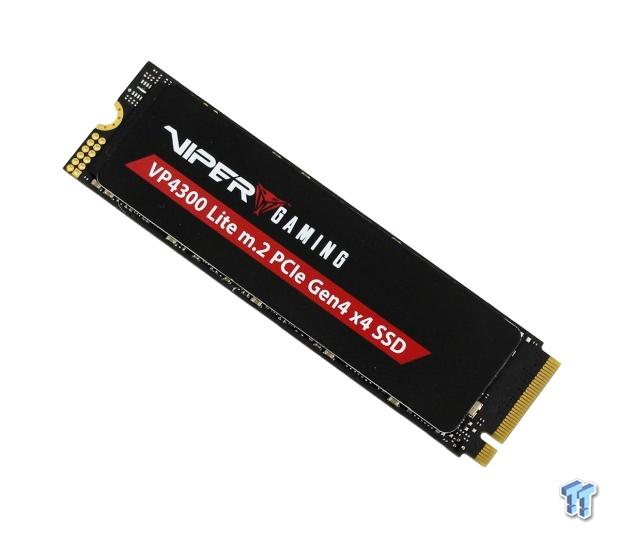
Not only do we consider the 4TB VP4300 Lite overall the best retail DRAMless SSD ever made to this point in time, taking price and form into consideration, but we overall prefer it to any SSD currently being sold. It is currently our new favorite SSD. Editor's Choice.

